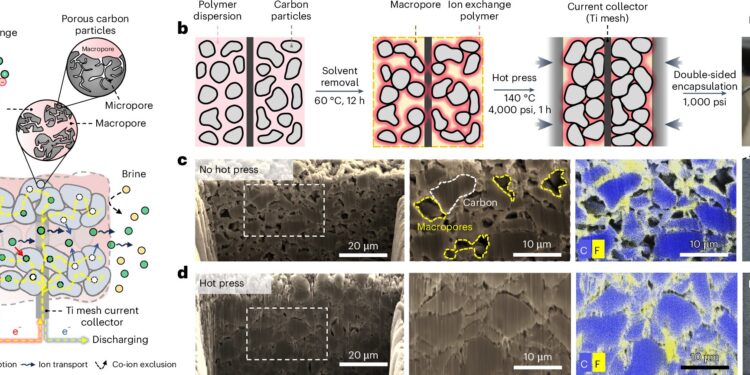Design, manufacturing and properties of CSE. Credit: Natural water (2024). DOI: 10.1038/s44221-024-00312-8
A team of Vanderbilt researchers has developed a new technology called electrochemical ion pumping (EIP) that could revolutionize water treatment and resource extraction.
The research, published in the October 1 issue of Natural waterovercomes a critical limitation of the commonly used process of conventional electrosorption, which uses electrodes to adsorb and remove ions from water.
According to the researchers, the practical use of electrosorption has been limited by the need to alternate charge and discharge cycles due to the limited capacity of the electrodes. During these frequent switchings, residual solutions in the electrodes mix with incoming solutions, reducing energy efficiency and ion removal efficiency.
However, the new EIP process addresses this long-standing problem by implementing an innovative circuit switching approach. Unlike traditional methods, EIP enables continuous, unidirectional ion flow without disruptive solution switching. This eliminates mixing, reduces operational complexity and improves separation performance, the researchers said.
EIP can also operate with very short charge-discharge cycles, which limits unwanted side reactions and opens new possibilities for electrode design, focusing on properties that improve ion separation rather than simple adsorption capacity.
Operating principle and proof of concept for EIP. Credit: Natural water (2024). DOI: 10.1038/s44221-024-00312-8
“We have effectively solved one of the major bottlenecks in electrosorption,” said Longqian Xu, principal investigator and co-inventor of the process. “By eliminating mixing during solution changeover, EIP can be used in a wide range of environmental applications with improved performance.”
Shihong Lin, associate professor of civil and environmental engineering and corresponding author of the paper, said the potential of EIP extends far beyond desalination.
“Everything that conventional electrosorption can do, EIP can potentially do much better,” said Lin, who hopes the platform will generate excitement within the electrochemical separation research community.
Potential applications include selective contaminant removal, water softening, nutrient recovery from wastewater, and metal extraction from natural brines and industrial wastewater.
More information:
Longqian Xu et al, Pseudo-continuous and scalable electrochemical ion pumping with circuit switching-induced ion shuttling, Natural water (2024). DOI: 10.1038/s44221-024-00312-8
Provided by Vanderbilt University
Quote: New research reveals potential of electrochemical separation for water treatment and resource extraction (October 1, 2024) retrieved October 1, 2024 from
This document is subject to copyright. Except for fair use for private study or research purposes, no part may be reproduced without written permission. The content is provided for informational purposes only.



